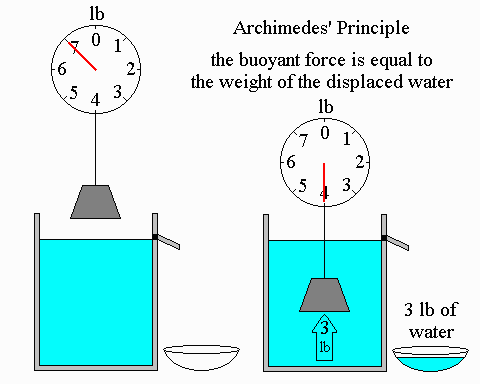EP 2.Buoyancy and stability
Principle of Buoyancy and Stability
1. Archimedes Principle’s Law: a body floating or submerged in a fluid is buoyed up by a force equals to the weight of the water it displaces.

ที่มา: https://physics.weber.edu/carroll/archimedes/principle.htm
2. Depth to which vessel sinks depends on density of water (r = 1 ton/35ft³ seawater, or 1.025 tonnes/m3), vessel sinks until weight of water displaced by the underwater volume is equal to the weight of the vessel.
ที่มา: https://byjus.com/physics/density-of-water/#What-is-the-Density-of-Water?
EP 1.Barge general details
Terminology, Definition and Principal Dimensions
- Perpendiculars – Imaginary lines perpendicular to the base line or plane (and the waterline)
- Forward Perpendiculars (Fpp or Fp) – This is the line crosses the intersection of the waterline and the front of the stem
- Aft Perpendicular (App or Ap) – This line usually aligns the center line of the rudder stock. This is the imaginary line around which the rudder rotates.
- Plimsoll Mark (freeboard mark) – The freeboard mark is a symbol indicating the maximal immersion of the ship in the water, leaving a minimal freeboard for safety.
ที่มา: https://www.sciencedirect.com/topics/engineering/forward-perpendicular
ที่มา: https://www.youtube.com/watch?v=6E0bT6B5Zm4&t=192s
- Port – The left-hand side of a vessel when looking forward
- Starboard – The right-hand side of a vessel when looking forward
- Bow – The front side or forward of a vessel
- Stern – The back side or Aft of a vessel
Seagoing Forces
A floating rigid body on water surface has six (6) degrees of freedom, three of translation and three of rotation.
For seagoing forces from a state of equilibrium, the vessel is referred to the movements as follows:
Linear motion:
Sway = Transverse translation in the direction of the y-axis
Surge = Longitudinal translation along the x-axis
Heave = Vertical translation along the z-axis
Angular motion:
Yaw = Rotation about a vertical around the z-axis
Trim or Pitch = Rotation about a transverse around the y-axis
Heel or Roll = Rotation about a longitudinal around the x-axis
Tips:
“Trim” and “Heel” terms are used in static or quasi-static conditions.
“Pitch”and “Roll” are used in dynamic situation which is dealt with under seakeeping.
BARGE LONGITUDINAL STABILITY (TRIM)
Trim or longitudinal stability is measured by the difference between the drafts at the forward and the draft at the Aft i.e. the trim fore (TF) + the trim aft (TA).
In proper trim, the draft of the forward equals the draft of the aft.
Barge Movement Can Affect Trailer Stability
- Stability required
- Geometric stability (min 14%)
- Hydraulic stability (min 10%)
- Transverse stability is usually the critical item
- Single trailer wide can be affected by barge heeling
- Sufficient ballast capacity for the whole operation
- Adequate barge stability during loadout
- Be patient – do not “push” along too quickly
- Wait for the correct ballasting to be done
Heavy Load Transportation & Loadout Technique
ผู้เขียนได้รับเชิญให้ไปบรรยายให้กับ วสท. ผู้เขียนได้เตรียมเอกสารไว้แล้ว เลยคิดว่าเอกสารประกอบการบรรยายน่าจะมีประโยชน์กับผู้สนใจทั่วไปด้วย ผู้เขียนก็เลยนำมาเขียนไว้ในที่นี้เพื่อใช้ในการศึกษาเบื้องต้น โดยผู้เขียนจะนำเสนอในแต่ละหัวข้อแยกย่อยออกไปเป็น EP เพื่อให้ง่ายต่อการศึกษา
ปล. ต้องขออภัยที่บทความและเนื้อหาส่วนใหญ่ต้องเป็นภาษาอังกฤษ เนื่องด้วยต้องการสื่อสารให้ครบตามความรู้และประสปการณ์ของผู้เขียนที่ได้ทำงานร่วมกับบริษัทที่ต่างชาติที่เป็น worldwide company
LOADOUT PROCESS – CONSIDERATIONS
EP 1.Barge general details
- Terminology, Definition and Principal Dimensions
- Seagoing Forces
- Barge Movement
- Transport Engineering - Stability
EP 2.Buoyancy and stability
- Principle of Buoyancy and Stability
EP 3.Hydrostatics, Barge tank layout and access
- Barge Types and Details
- Furniture And Fittings
EP 4.Barge ballasting
- DNV Requirements
- Noble Denton Requirements
- Types of Pumps
EP 5.Barge strength
- Loadout Calculations – Barge Stresses
EP 6.Mooring and berthing
- Barge Mooring – Initial Considerations
EP 7.Linkspan Bridges
EP 8.Type of loadout
- Bow or Stern End Loadout
- Side Loadout (Port or Starboard)
- Floating Loadout (tidal or non tidal)
- Grounded Loadout (tidal or non tidal)
- Type of trailer for loadout
- SPMT
- Other Trailer
- Skidded Loadout
- Lifted Loadout
EP 9.Loadout planning step by step
- Loadout criticality may be defined by MWS taking into account
- Tidal variation
- Weather conditions
- Barge dimensions (stability and GM values)
- Categories range from the most critical to least




